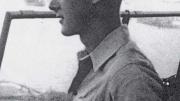New York attorney Robert M. Pennoyer reports speaking at his class of 1946’s reunion lunch at the Faculty Club, on May 25—billed as its last reunion. In case that is so, some of what he had to say about World War II deserves permanent recording. The class enrolled in September 1942, after Pearl Harbor, he notes. Among the recollections:
At Harvard that September, along with Tommy [Lamont, who died in a submarine in 1945], Norman Walker, Frank Hatch, and countless other friends and classmates, I enlisted in the Navy’s ROTC program. The Navy took control of life at Harvard. Most of us were in uniform. In my last year some of us were “billeted” in Kirkland House, renamed “U.S.S. Kirkland.” Instead of floors, walls, ceilings, rooms, beds, and stairs we had decks, bulkheads, overheads, compartments, bunks, and companionways. When a bugler woke us up at six we put on Navy issue sweatpants and “formed up” in platoons, in the courtyard, then ran in formation to the Charles River for a half-mile run before returning to “the chow line” in the “mess hall.” Before going to class we had to make our “bunks” (learning to make a “Navy corner” came in useful later!)…and make sure our “compartment” was ready for inspection by a warrant officer….
In October 1944, working through two years with no vacations to complete the credits needed for a college degree and our ROTC training, Frank Hatch and I, at age 19, received our college degrees, our ensign’s commissions, and orders to report to the cruiser Pensacola somewhere in the Pacific. It took a month to cross the Pacific to find the Pensacola in the harbor at Saipan, about 1,200 miles from Japan, that had just been taken by the marines. A few hours after we boarded, a voice over the ship’s speaker ordered all officers to the wardroom. When we had assembled, the ship’s executive officer, Commander Behan, uncovered an eight-foot scale model of…Iwo Jima. He explained that the next morning our ship, along with two other cruisers and six destroyers, would sail for Iwo, some 600 miles closer to Japan, where we would bombard targets he pointed out on the model.…
The ship had a crew of 1,000, all volunteer, all young.…The day before the landing at Iwo Jima, the ship was heavily damaged by Japanese shore fire, with almost 150 killed and wounded, when we closed to within one mile of the island to attack guns overlooking the landing beach.…I was in the main battery turret just forward of the bridge. Frank Hatch was two decks below the bridge in CIC, Combat Information Center, which controlled the ship’s radar. Another shell, exploding through the deck in the gap between my turret and the bulkhead leading up to the bridge, blew in the back of my turret and destroyed CIC. When we were out of range and ordered to put out the fires and help the wounded, I ran to the passageway leading to CIC and found Frank sitting on the deck outside the door to CIC, dazed but not seriously wounded. Of the 13 men in CIC he was one of four to come out alive. The night before, when we knew that our ship would be in trouble…before climbing…to stand a four-hour watch at the top of the mast 140 feet above the sea, I had given Frank my lucky piece, a large silver Napoleon coin with the date 1808, telling him, “Here, you may need this.”
…When the war ended in August 1945, I became the first American to land on Hokkaido.…Our ship was ordered to participate in the occupation of northern Japan, and when we dropped anchor in the harbor at Hakodate on the south coast of Hokkaido a few days after the surrender was signed in Tokyo Bay, the captain ordered me, one of the youngest officers on the ship, to “take 20 sailors, with no weapons, and find a way to get ashore to let the Japanese know the Americans have arrived.”
…In May 1946, when Frank and I walked down the gangplank for the last time in San Diego, there was no place to sleep in town, and the Navy bussed us up to the zoo which had been emptied of animals during the war, where we spent the night on cots in the monkey house, with the sign “Baboon” on the cage. From there, there was nowhere to go but up.







